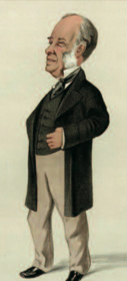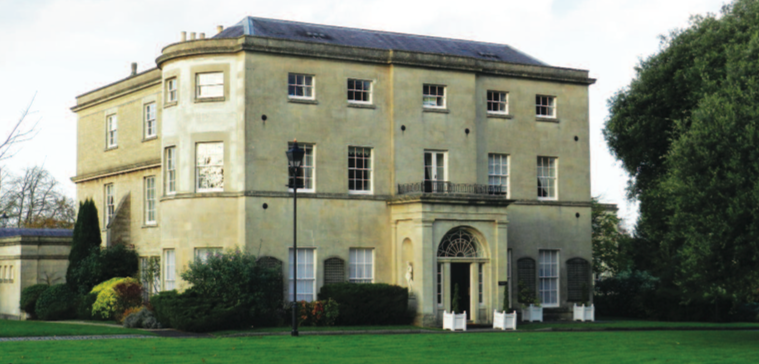
Sir Gabriel Goldney as depicted in Vanity Fair in 1872
Who were the Goldneys? If we go back to a document entitled The History of Parliament: The House of Commons 1509–1558, we learn that Henry (born before 1517), was the son of a wealthy farmer and clothier named Nicholas Afternewell. The will of Nicholas was apparently proved in 1538, but it did not specify the ages or seniority of his children, which seems to have caused a family rift – it resulted in Henry sueing his mother and her new husband in 1539 for the loss of some 240 acres of land at Chippenham and Langley, of which he had been named as his father’s heir.
From September 1549, Henry’s surname was identified as being changed to Goldney, and it has been used by his descendants ever since.
Many of the Goldney family are known to have come from the Bristol area. Thomas Goldney I (1620–94) was the first of three generations each named Thomas. He became a very successful merchant and played a part in the activities of the newly formed ‘Society of Friends’, or Quakers, in the city. There is a Goldney House at Clifton, Bristol, and also a Goldney Avenue and Goldney Road.
Some of the family had already spread as far as Chippenham, where they had set up as clothiers in the town. Henry Goldney had been a Member of Parliament for Chippenham and in 1553 was appointed as the first Bailiff of Chippenham. (Goldney Avenue in Chippenham is named after him). In 1558, he bought a forty-year lease on the manor house at Rowde. This was indeed a wealthy and powerful local family.
Research into the intervening years 1600–1800 is difficult. From 1617 to 1790, there had been a succession of Gabriel Goldneys, probably first sons of the line, but it is difficult to confirm the facts. From the nineteenth century, however, it is easier to establish the accomplishments of the family.
Sir Gabriel Goldney (1813–1900) was created ‘1st Baronet of Beechfield, Corsham and Bradenstoke Abbey’ in 1880. He had married Mary Anne Alexander of Corsham in 1839, and it is believed that he acquired Beechfield House in Corsham in the mid-1800s. There were four children, Mary, Gabriel Prior, Frederick and John. As a landowner, financier and banker, he was able to purchase Sheldon Manor in 1854 and Bradenstoke Abbey in 1863 from Frederick Methuen, 2nd Baronet. He also owned land at Monks Park, which he leased for quarrying. Pickwick District School (now St Patrick’s Church) was also built for Sir Gabriel, and its design was exhibited at the Royal Academy in 1857.* First elected as an MP in 1865, he was a Director of the North Wilts Bank and Deputy Lieutenant of Wiltshire in 1869. He was also a Freemason and Grand Warden of England.

Beechfield House today
The 2nd Baronet was Gabriel’s eldest son, Gabriel Prior Goldney (1843–1925). He became a barrister, JP for Wiltshire and High Sheriff of the county in 1906. Unmarried, he resided at Derriads in Chippenham.
The title then passed to his brother, Frederick Hastings Goldney (1845–1940.) Married to Ethel Swayne of Wilton, the 3rd Baronet was a landowner, Freemason and author of The History of Freemasonry in Wiltshire (1880). He later became Mayor of Chippenham, High Sheriff of Wiltshire in 1908, and JP for Wiltshire and Surrey. He was married with five children, Katherine, Mary, Eveline, Lucy and Henry. He lived at both Beechfield House and in Camberley, Surrey.
His daughter Eveline, married Graham Dunsterville of Guyers House in 1912. The families had been close and attended Corsham Church together for Sunday services. Graham rejoined his regiment, the Devonshires, in 1914 and was killed in action in France in October 1914. His son Hugh was born at Guyers in December of that year. At Hugh’s christening in February 1915 the two families, Dunstervilles and Goldneys, planted an avenue of walnut saplings, six each side, running from the rear of Pickwick village street, into Middlewick Lane and the Beechfield estate. Hugh tells us that when the site was developed for housing, most of the trees were felled, but two or three have Tree Preservation Orders and have survived.
A third son John Tankerville Goldney, (1846–1920) went abroad. He was Attorney General for the Leeward Islands and later became Chief Justice of Trinidad in 1893. In 1913, in his later years, he married Miss Alice Goldney.
The title finally passed to Frederick’s only son, Henry Hastings (1886–1974). Married but with no children, Henry lived at Rowden House, Chippenham. He served in the Royal Engineers, and was awarded the Military Cross in 1917 for ‘conspicuous gallantry under heavy fire’. He is buried at St. Bartholomew’s, Corsham, with many members of his family.
The ladies of Sir Frederick’s family took a significant part in the running of the Corsham Hospital at the Town Hall during the First World War. On the Memorial tablet in the Hall it lists Lady Goldney as Commandant, Alice Goldney as Assistant Commandant, and Nurses Katherine, Lucy and Marjorie Goldney. The Wiltshire Times of January 2000 tells us that one of the daughters was a district nurse, visiting the houses of the poorer residents in the vicinity and taking presents at Christmas time. Miss Goldney rode a ‘sit-up-and-beg’ bicycle and could often be seen riding one-handed while holding an umbrella aloft .
In 1948, Frederick’s daughter Katherine Long Goldney and her brother Henry undertook to sell at auction a great deal of the Pickwick village estate as it stood at that time – it is believed to have been owned by the family since 1857. Most of the houses were tenanted, and some occupiers were able to buy their properties, but others may have been transferred to a new landlord. This included 26 houses or cottages, the Old Malthouse, village stores, the Old Brewery and Manor House Barn. The auction realised a value of £17,460 – quite a bit of property!
The Goldneys being a Quaker family, the men heavily involved with Freemasonry and reaching high office in that organisation, it has long been thought locally that the Masonic Hall in Pickwick was once a Quaker meeting house. However, a letter has recently come to light written by Katherine Goldney, living in Camberley, dated 7 November 1967, to her brother Harry (presumably Henry) in which she states:
‘You are right … Mr. Fry’s daughter married a Mr. Matthews and they bought a house at the end of Pickwick village. It was a very appropriate place of abode, as Mrs. Matthews was a Quaker, and as you know Pickwick was originally a Quaker village, built by Quakers who also built the Meeting House at the village end. By the time our grandfather bought Beechfield and Pickwick, the Quaker inhabitants had died out, so as the Meeting House had not been consecrated he turned it into a club, for his male tenants in Pickwick, and paid for its gas and newspapers for the Club. All went well for several years until two men arrived and said they were executors of the former Quakers, and had orders to pull the Meeting House down and sell its contents. Our Grandfather told them he had turned it into the village club, and offered to buy it from them, but they refused. So he bought two of the original benches, and put them in his billiard room. The Meeting House was duly demolished.’
It has since been established that the Meeting House stood at 21 Pickwick. We would recognise the site now as being on the left-hand side at the entrance to Woodlands, where new houses were erected in 2013. The plot had been the garden of the large house opposite The Brewery, which is the residence of the Eden Family.
A further letter from Pickwick resident Robert Currey in 2003 discusses the same subject and says that the Masonic Lodge is actually on the site of the Goldney billiard room (which is borne out by the Listed Buildings record for Pickwick) and that a large 1836 map of Corsham shows the Quaker Meeting House to be at the Chippenham end of Pickwick village. Apparently there is a walled garden at the rear of the Masonic Lodge and 41 Pickwick next door, which is believed to have been a Quaker burial ground, but that is unverified.
Beechfield House was requisitioned by the army during the Second World War and was taken over by Bath Academy of Art in 1946. It is believed they remained in situ until 1986, when the Academy returned to its home in Bath. The site then remained derelict until the mid-1990s when Gleeson Homes purchased the site to build Academy Drive as we know it today.
Pat Whalley
Sources: Miscellaneous papers held by Corsham Area Heritage, donor unknown. The History of Paliament 1509–1558, ed. S. Bindoff, 1982. Wiltshire Times, January 2000. Internet site of Robert Currey, local resident of Pickwick.